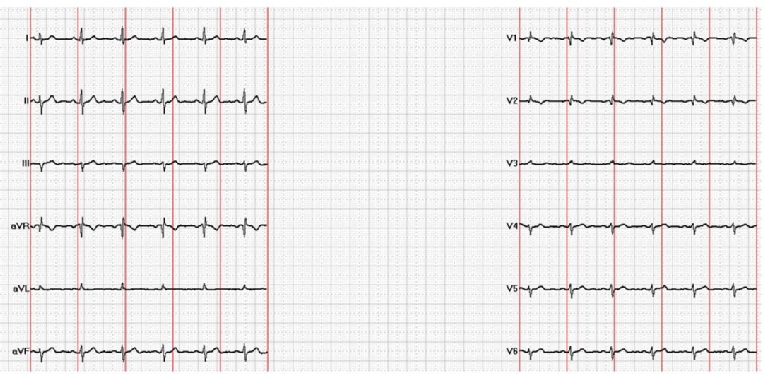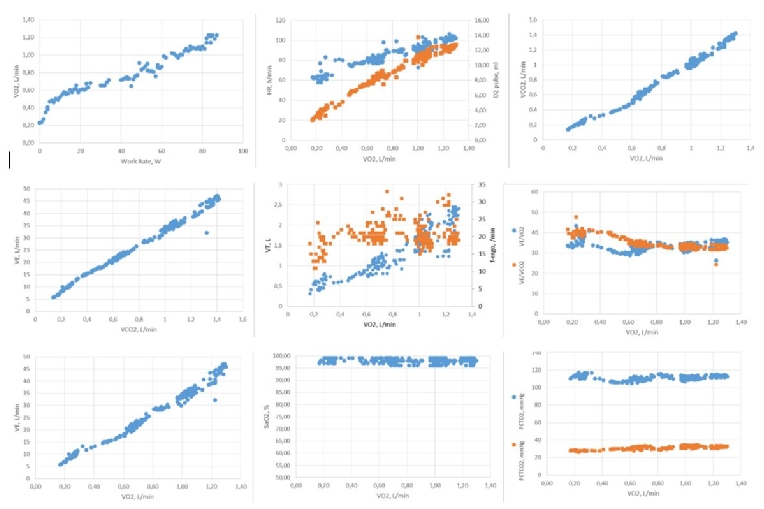The case
Description:
- A male patient (61 years old, non-smoker, BMI 24.8 kg/m2) has a history of congenital corvitium, type Partial Anomalous Pulmonary Venous Return (PAPVR) and patent foramen ovale (PFO).
- He contacted us for a diagnostic work-up of reduced exercise tolerance and exercise-induced dyspnea (NYHA II) of unknown origin.
- He takes no medication.
- His baseline clinical examination is normal.
- The baseline electrocardiogram is shown in Figure 1.
- His N-Terminal pro-B type natriuretic peptide (NT-pro BNP) level was 124 pg/ml.

Test findings:
- Pulmonary function test (PFT) was performed: Forced Vital Capacity (FVC): 82% predicted, Forced Expiratory Volume in 1 second (FEV1): 80% predicted. FEV1/FVC ratio > 70%.
- The resting transthoracic echocardiography shows a non-hypertrofied, non-dilated left ventricle (LV) with a normal EF (68%).
- The right ventricle (RV) is lightly to moderately dilated (Basal RV D: 4.1 cm, Mid RV D: 4.0 cm, Base-to-apex RV D: 8.8 cm, RV/LV basal D: 1.0), with a normal RV systolic function (RV FAC: 52%, RV S’ 10 cm/sec, TAPSE 24 mm) and no resting pulmonary hypertension (PAPm rest: 14 mmHg).
- There is a 40% left-to-right shunt fraction (Qp/Qs: 1.4).
We subsequently performed a combined exercise echocardiography and cardiopulmonary exercise test in order to investigate the cause of the patient’s main complaint. The main results of the cardiopulmonary exercise test are summarised in Table 1, those of the exercise echocardiographic examination in Table 2.
- This test was terminated due to leg fatigue.
- There was no evidence of arrhythmia and/or ECG changes suggestive of ischemia during the test.
- The systolic blood pressure increased normally.
- The Oxygen Pulse (πO2) showed an initial increase in a hyperbolical fashion, followed by a slow approach to an asymptotic value (i.e. no πO2 flattening and/or decline) during exercise.
Table 1. Cardiopulmonary exercise test results
| Parameter | Measured Value |
|---|---|
| RER max | 1.03 |
| HR peak (% pred) | 72 |
| VE peak/MVV | < 80% |
| VO2 peak (% pred) | 51 |
| VT1 (% VO2 max pred) | > 40 |
| OUES (ml/min/log[ml/min]) | 1537 |
| OUES (% pred) | 65 |
| VE/VCO2 slope | 30 |
| VE/VCO2 slope at VT1 | 31 |
| ∆ VO2/∆W | 10, no slope flattening |
| ∆SaO2 | < 4% |
RER: Respiratory Exchange Ratio; HR: Heart Rate; VE: Minute Ventilation; MVV: Maximal Voluntary Ventilation; VO2: Oxygen consumption; VT1: First Ventilatory Threshold; OUES: Oxygen Uptake Efficiency Slope; W: Load.

Table 2. Exercise echocardiography test results
| Parameter | Resting value | Low intensity | High intensity |
|---|---|---|---|
| Load (W) | 0 | 25 | 83 |
| PAPs (mmHg) | 20 | 30 | 40 |
| PAPm (mmHg) | 14 | 20 | 26 |
| RV FAC (%) | 52 | 56 | 62 |
| RV S’ (cm/sec) | 10 | 12 | 18 |
| PAPm/CO slope | 2.74 | ||
| PAPs/W slope | 0.23 | ||
| RVESPAR ratio | 2.75 | ||
| LV EF (%) | 68 | 72 | 74 |
| E/E’ | 7.5 | 7.0 | 8.1 |
W: Watt; PAPs: systolic pulmonary artery pressure; mPAP: mean pulmonary artery pressure; RV: right ventricle; FAC: fractional area change; CO: cardiac output; RVESPAR: right ventricular end-systolic pressure area relation; EF: ejection fraction; LV: left ventricle.
Test your knowledge
Interested in learning more?
Access the ESC e-Learning Platform and discover the EAPC Sports Cardiology online courses.
Not yet an EAPC Member?
Note: The views and opinions expressed on this page are those of the author and may not be accepted by others. While every attempt is made to keep the information up to date, there is always going to be a lag in updating information. The reader is encouraged to read this in conjunction with appropriate ESC Guidelines. The material on this page is for educational purposes and is not for use as a definitive management strategy in the care of patients. Quiz material in the site are only examples and do not guarantee outcomes from formal examinations.



 Our mission: To reduce the burden of cardiovascular disease.
Our mission: To reduce the burden of cardiovascular disease.